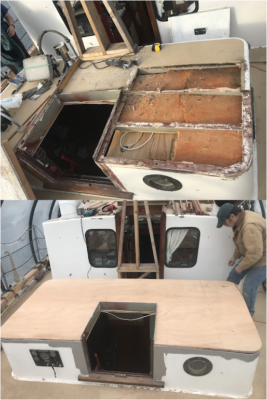While some of you are well aware of all the maintenance work done on the boats during the winter, many are probably curious about the type of work we do during this time of year. During the season folks always ask me, “What do you do in the winter?” I always chuckle thinking the expected answer is, “I head down to the Caribbean and don’t think about Inland Seas until the spring.” As much as I wish that to be true, I always give an answer that compares our operation to that of any stage production. When you go to a play or musical, you spend a couple of hours in your seat seeing the beautiful sets and their seamless changes between scenes, sometimes a choreographed musical score, while a story is told by numerous actors working together in this machine of theater. What you don’t see are the many hours, days, and months spent building, decorating, and practicing. All of the time and work spent just to tell a story over the span of a couple of hours. The Inland Seas program is not very different and my part of this production is all the work on the boats that need to be done to keep our production running smoothly during the season.

This winter, volunteers and I have been busy with several projects that are both regular maintenance as well as some minor improvements. Many of our winter maintenance projects are done every year while Inland Seas is in winter layup. (Inland Seas is still in the water with a bubbler system and we work under a winter cover.) These projects are done in order to keep her in good operating condition and are relatively small projects we do before they become big, expensive overhauls as well as to minimize the risk of a breakdown during the busy season. Among these yearly projects are the reconditioning and inspection of the spars, cleaning away rust for repainting, varnishing, block maintenance, and engine maintenance.
Some of our bigger projects are things that are not regular, but beyond simple maintenance or just plain worn out. These need to be repaired or replaced. This year we had a run of an exhaust hose that began to leak so we replaced the old hose with a brand new one. It’s a big 12-foot long by 4-inch diameter hose. It was a bit of a wrestling match getting the old one out and putting the new one in.

We are also replacing the top of the aft cabin. Over the years, water has infiltrated the fiberglass coating and gotten into the plywood. This has caused the plywood to delaminate and rot over time. Removing the old cabin top is a demolition process that takes several days due to it being well attached. This type of project takes a lot of muscle since, although starting to disintegrate, it is still well attached but it also requires great care to remove. While tearing and cutting the old pieces we want to make sure we don’t damage the pieces left in place. After reconditioning the underlying steel, the new cabin top will be installed, glassed over, and painted.

Another project falls under the improvement category. Our galley stove is fed by a propane tank located in a locker mounted on the deck. Due to the size of this locker, the galley stove has always had to use a smaller 10 lb. tank since the ship was built. These have been difficult to fill when we are away from our homeport since there isn’t always a filling station readily available. They have less capacity and are also suspected of providing less pressure when multiple burners are in use. We eventually decided to increase the size of our propane locker to accommodate a larger 20 lb. tank that is commonly used for any regular backyard barbecue. Not only do they have a larger capacity, but they can easily be exchanged for a full tank in nearly every port we visit thus eliminating the need for a filling station.
This project involved cutting away the old locker, then fabricating and welding in a new one. Those that are familiar with the boat will probably not even notice the change. ACE Welding from Traverse City has done the fabrication and welding of the new locker. One more minor, yet significant improvement to the overall operation when we travel from port to port.

For Utopia, it is a haul-out year. She’s sitting up out of the water at the Northport Bay Boat Yard. There aren’t any major projects happening, but rather just a “shave and a haircut” so to speak. What this means is that we’re doing some minor hull maintenance below the waterline and will be applying a new coat of bottom paint once the weather warms to the point that paint can be applied. Once springtime is here, however, Utopia will be getting some repairs to a few of her planks above the waterline. That’ll happen once she’s in Discovery Pier sometime in May and June.
We have many other smaller ship projects going on as well and are always looking for additional help. Feel free to stop by the boat if you are in the area and happen to see the company vehicle parked nearby.
This blog was written by Ben Hale, Inland Seas Captain. Ben was one of our early interns in 1997. After receiving his Bachelor of Zoology, he helped crew and sail tall ships in not only our Great Lakes but in the oceans as well. Ben came back to join our staff in 2012. In addition to captaining the ships, his main responsibility is ship operations and maintenance, but he also takes care of other campus and facility tasks in the non-sailing season. If you would like to help Ben with repair and maintenance, contact him at bhale@schoolship.org.